the rosewoods
open main page for all woods open page 2 for articles
THE ROSEWOODS, REAL and OTHERWISE
contents:
- INTRODUCTION
- BUYING ROSEWOODS
- IDENTIFYING ROSEWOODS
- ROSEWOOD CHARACTERISTICS
- WORKING WITH ROSEWOODS
- GENUINE SPECIES
- COMMON SUBSTITUTES FOR GENUINE ROSEWOOD
- PLANTATION GROWTH
- TOXICITY
- CONCLUSIONS
INTRODUCTION
Rosewood are, and have long been, prized exotic woods throughout most of the world, including both locally where they are native (in which case they are not actually "exotic") and places such as the USA where they have to be imported. Because of the commercial value of the rosewoods, many vendors attach the name "rosewood" to woods that are NOT rosewoods. Some of these are similar to rosewoods in characteristics, some are not. Some of this mis-identification is innocent, some is not.
"True" or "genuine" rosewoods are all of the genus Dalbergia of the family Fabaceae (syn. Leguminosae) the legume, pea, or bean family, and were named "rose"-woods because many of them give off a smell, when freshly cut, like that of the rose flower. Although all true rosewood are of the genus Dalbergia, not all of the species in the genus Dalbergia are considered rosewoods. A few rosewoods, most notably cocobolo and kingwood, are not normally sold with the word "rosewood" in their name.
There are perhaps 50 to 60 species within the genus Dalbergia that are large enough to produce wood at least large enough for pen blanks and many that grow to quite a respectable size. As a general rule, the rosewoods tend to be small to moderate in size and often irregular in shape, thus making sizeable planks the exception rather than the rule for most of the species, and really wide planks, such as one might find for bubinga or mahogany, to be non-existent. True rosewoods are often made into veneer since a veneered surface looks just as good as solid wood (if one ignores the edges) and veneer produces WAY more surface area than solid wood and thus produces far more value from a tree than do planks. On the other hand, the irregularity of growth often prevents rosewoods trees from being veneerable.
Overharvesting of true rosewoods during the last 100 to 200 years has resulted in current embargoes on some of them, most principly Brazilian rosewood, long one of the favorite of all the rosewoods because of both its beauty and its tonal qualities for musical instruments. Availability and pricing will have fluctuated and will continue to fluctuate over time depending on political considerations in the countries of origin and sometimes with weather conditions which can reduce logger's ability to (1) get at the trees and (2) get them to market.
There are a few woods that are widely sold as rosewoods, even though they are not, which are actually quite attractive; some of them are as attractive as true rosewoods. Then there are at least 100 species of wood that just have "rosewood" in their name but really should not, since they are not in any way related to rosewoods (except that they are both wood) and they are not as attractive nor do they necessarily have similar working properties. Part of the reason for this article is to distinguish among many examples of these different types.
BUYING ROSEWOODS
Because of the popularity and expense of true rosewoods, MANY products sold as rosewood, or even "genuine rosewood" are total trash. Caveat emptor.
If you are buying "rosewood" from any but the most trusted and respected vendors, you may well get something that is not, and sometimes not even close to, rosewood. Caveat emptor.
The variability of beauty-enhancing characteristics such as color and grain pattern is very high in many of the true rosewoods, so they are NOT a good wood to buy sight-unseen. I have, for example, seen pieces of genuine Brazilian rosewood that look like crap. Caveat emptor.
I don't mean to be overly alarmist in this. I'm an amateur woodworker who has bought a grand total of maybe 30 or 40 BF (if that much) of various rosewoods over many years, and I'm confident that all of my purchases have been of true rosewoods when advertised as such and most of them have been very attractive.
I HAVE seen furniture items for sale that I KNOW were falsely advertised as "rosewood", but the stores making the sales did not necessarily know themselves that they were selling falsely labeled items. Wood wholesalers may sometimes get cheated by dishonest vendors from foreign contries and then those wholesalers propogate the deception in order to not lose money and by the time the wood ends up in a product, the sellers may have no idea that it is not actually rosewood in the items they are selling. And, of course, there ARE dishonest manufacturers and vendors, so caveat emptor.
IDENTIFYING ROSEWOODS
My own web site is, as far as I know, the best single source of accurate pictures of the various true rosewoods and the other woods mentioned in this article. Keep in mind, however, that the variability of color and grain in many of the rosewoods is absolutely staggering and even though I have MANY pics of some of the rosewoods (I was for quite a while, absolutely ADDICTED to taking pics of cocobolo), you may find a piece that doesn't look quite like any of MY pics but that fact in and of itself certainly doesn't mean the piece is not genuine.
The best pieces of the better rosewoods, such as East Indian rosewood and cocobolo, are just amazingly beautiful and are not likely to be confused with any other woods. The variegated colors, including bright reds, oranges, and purples, combined with contrasting dark streaks, make these woods stand out like few other woods can. Other rosewoods, or even lesser pieces of the best species, can be hard to identify ... it's just a matter of experience. Again, my site is a good place to start but not by any means the only place to look. And I find that sometimes, even when you are holding a piece, as opposed to looking at pics on the internet, it can be near-impossible, or even impossible, to figure out what wood you've got. AND, like most woods, rosewoods WILL have some pieces that are NOT all that attractive and you might not even think they really ARE rosewood.
Many of the rosewoods, especially cocobolo, tend to be oily so that can be a clue. Any wood that purports to be cocobolo, for example, that is not oily is highly suspect.
ROSEWOOD CHARACTERISTICS
The rosewoods are hardwoods and, unlike some hardwoods, are REALLY HARD. And heavy. And dense. And beautiful.
Densities range from about 50 lbs/cuft to about 75 lbs/cuft depending on the species and sometimes even the particular piece. For example, I have noted the density of every piece of cocobolo I've ever bought and found that the range for my set of 20 or so planks (ranging from quite small to only modest in size) was 60 to 79 lbs/cuft with most of the pieces being from 65 to 75 lbs/cuft. Their density makes rosewoods very durable, both mechanically and chemically.
The heartwood tends to be oily and this combines with the density to have some considerable implications in how the woods are worked (more on that under WORKING WITH ROSEWOODS below). Resins may also be present, and can also be a problem in working.
Despite their density, rosewoods have a slightly open pore structure, some much more than others. Cocobolo, for example, is very fine-grained, but others can soak up a fair amount of finish. Fillers may be called for; it's a matter of judgment based on species and individual pieces.
The sapwood on genuine rosewoods tends to be a very bland white or whitish-tan color, sometimes with a yellow tint, and is softer than the heartwood. The sapwood is susceptible to insect attack but insect holes tend to be fairly small.
Like many woods, rosewood can be subject to mineral deposits getting sucked up from the roots into the tree, and although I've never experience this problem myself, anecdotal reports say that it can be partiularly problematic on small, irregularly shaped trees (but I think that does not directly have to do with the shape of the tree, but rather that the irregularity of growth is indicative of mixed soil conditions, which is more directly the cause of minerals getting into the sap).
One fairly severe problem with the rosewoods, and like many of its characteristics this is tied to the density, is that they can be difficult to dry without degrade; checking in particular can be a problem.
WORKING WITH ROSEWOODS
Most Dalbergia species are oily and this can cause problems with gluing and finishing. With some rosewoods, and cocobolo comes particuarly to mind with this, the denseness of the wood and the natural oiliness can be combined with buffing to create a "finish" that is better than chemical finishes. Because of the oiliness, some finishes (particularly polyurethane and other oil based finishes) do not adhere at all well, but this can easily be overcome with a few thin coats of dewaxed shellac. Rosewoods tend to be so beautiful that anyone who even gets NEAR them with a can of stain should be taken out and shot.
Many Dalbergia species sometimes contain resin and this can cause some problems, particularly in gluing and finishing and if heavy, in machining as well. I have definitely experienced (and seen extensive anecdotal comments to the effect) that gluing is best done very shortly after machining/sanding operations, NOT after the wood has sat around for a few days. Also, many woodworkers highly recommend acetone to remove the surface oil before gluing. Personally, I have found this to be sometimes ineffectual, at least with cocobolo. I once had a piece that gave me a great deal of grief in finishing, so I completely stripped and re-sanded it and immediately rubbed it down quite vigorously with acetone, then waited a few minutes and again rubbed it with acetone, and then did that one more time. Each time, the rag I was using came away quite red, although noticeably less so on the 3rd application. I then applied polyurethane, and a month later it was STILL not dry. I assure you that I am not exaggerating when I say a month. That was when I looked for advice and found out about using dewaxed shellac as a barrier coat and I have not had a problem since (but I DO sometimes have to put on 4 coats of dewaxed shellac). I have heard others comment that acetone is not always effective but everything I have seen supports my belief that dewaxed shellac is always effective.
The density of rosewoods makes them a little tough to work sometimes. Sharp tools are a must. Also because of the density, pre-boring for screws is always the best idea. As for nails, basically you just shouldn't use nails on rosewoods (preferably don't use screws either) ... use good joinery and good glue so as to not do anything to detract from the beauty of the wood. Screws, of course, are sometimes not optional, especially for things like hinges, but they should be avoided if possible.
GENUINE SPECIES
(not even close to an exhaustive list)
(note that the stated price ranges are averages as of 2011)
AFRICAN BLACKWOOD (Dalbergia melanoxylon) is dark purple to black in color and has grain lines that range from slightly visible to barely visible at all. It is an incredible pleasure to turn and is widely used by luthiers in wind instruments. It is particularly expensive and rare and only comes in small sizes, which when prorated out to BF quantities can run to hundreds of dollars per BF. When available in large turning or small lumber sizes, it runs from $40/BF to $100/BF. Like ebony, it is an excellent contrast wood for segmented turning. I have never seen it in veneer form. In the composite pic below, the left-most pic shows an artificially lightened color so that the grain will show up decently.

BRAZILIAN ROSEWOOD (Dalbergia nigra) is the "gold standard" for luthiers (most particularly for guitar sides and back) because of its tonal qualities and beauty but is very limited in availability now due to overharvesting and subsequent embargoes from exporting it out of its native Brazil. The color ranges from dark brown or even tan to purples and reds, all with dark veining. It is somewhat unusual, for a rosewood, in a couple of ways. First, the tree grows much larger than most rosewoods. Second, it is rather coarse for a rosewood and third, it is relatively light as well, at typically 45-55 lbs/cuft. Despite the relative coarseness, it reportedly takes a good natural polish. Availability is very low and prices are very high. It has been illegal to export this wood from its native area since 1967 and what little you do see on the market (supposedly "pre-Cites") is of dubious provenance, so I would not hazard a guess as to what the price range is or should be. Not being a luthier, I cannot comment on the tonal qualities, and assume that its reputation in that regard is well deserved, but I personally think that this is one rosewood that is oversold in terms of beauty. For me, it is one of the less attractive rosewoods, and while occasional pieces ARE really beautiful, on average it is downright pedestrian when compared to cocobolo.
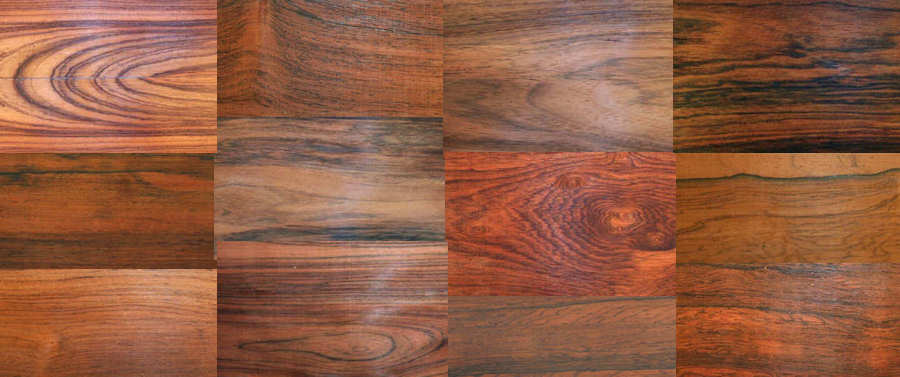
COCOBOLO (Dalbergia retusa) is my personal favorite of the rosewoods (and I know from woodworking forums that I'm nowhere near alone in that). The variability of color and grain is VERY large and can range from moderately bland and straight-grained to stunningly wild and colorful. I have seen a highly figured small piece of cocobolo sold for an amount that pro-rated out to $1000/BF (this is VERY unusual, but gives you an idea of how extremely beautiful it can get). Colors are all over the map, with the bland pieces being mostly dark purple and fairly straight-grained to wildly colored reds / oranges / violets, and all with a dark veining that ranges from mild to spectacular. This is a VERY oily wood and does not take oil-based finishes well and is generally quite dense/heavy, at 65-75 lbs/cuft. You should read about its toxicity if you are new to working with it. Available only in modest sizes and costing relatively little, I think, compared to the beauty. At $20-$25/BF, I think this is the best "bang for the buck" of all the rosewoods in terms of a combination of fairly reasonable price and extreme beauty. The color does darken, sometimes severly, with time and exposure to UV and oxygen.
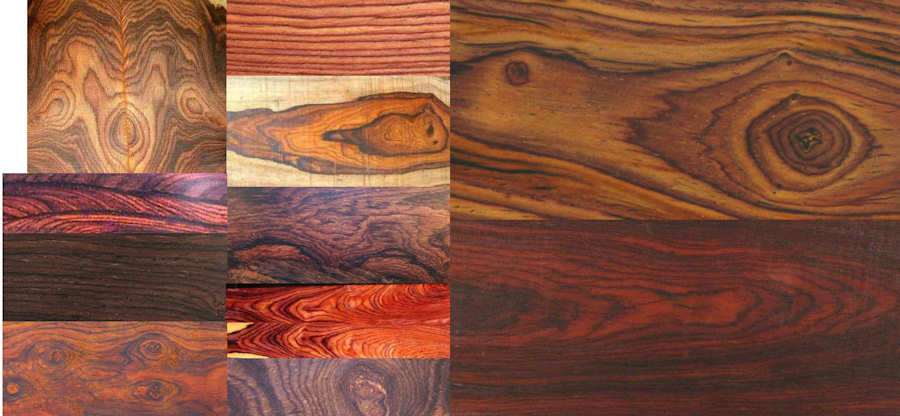
EAST INDIAN ROSEWOOD (Dalbergia latifolia) is one of the most variable of the rosewoods in terms of color; it's usually purpleish or purple-brown with dark veining but can have heavy streaking of violet, red, yellow and blue that can make it beautifully colorful. The grain is less wild than some of the rosewoods, and ranges from moderately bland to very attractive. Can sometimes be confused with kingwood when mostly purple and relatively bland. Often used by luthiers as a substitute for the more expensive and less available Brazilian rosewood, especially for guitar sides/backs. A relatively light rosewood, generally in the range of 45-55 lbs/cuft and costing in the $25/BF range.
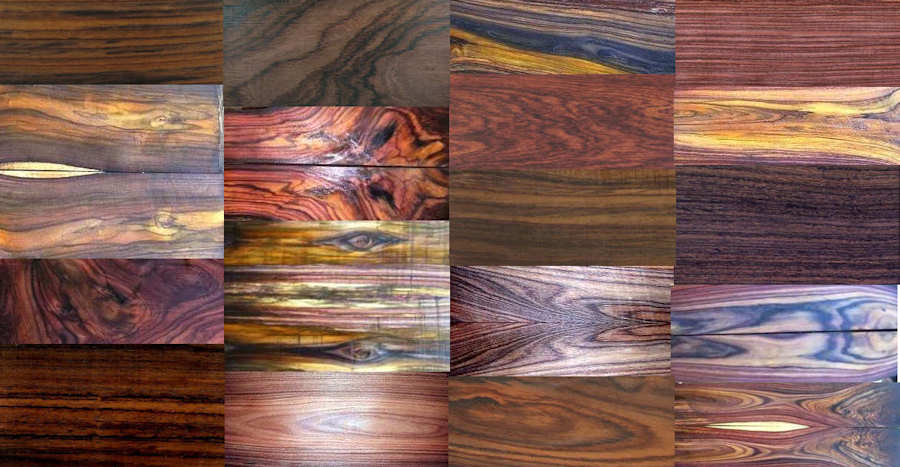
HONDURAN ROSEWOOD (Dalbergia stevensonii) generally has a very attractive purple/brown color, sometimes lighter reddish-brown and with dark veining; this is still one of the less variegated (in figure) rosewoods and sometimes remarkably similar to bubinga. It is very strong and has good tonal qualities, making it popular with luthiers. It is fairly fine-grained and works well. Weights in the 55-65 lbs/cuft range and costs about $20-$25/BF.

KINGWOOD (Dalbergia cearensis) Native to Brazil, this wood is generally purple to purplish-brown with dark veining and is VERY attractive. It is called "KINGwood" because it was, for a long time, the favorite wood of European monarchs for their furniture. It is very hard and strong and dense (in the 70lbs/cuft range), really wonderful to work (despite the density) and being fine-grained, will take a high natural polish. It CAN be a bit brittle, so you have to be careful about chipout. Currently available only in small sizes (I'm not sure how it was 200 years ago) and fairly rare and expensive, costing in the $40/BF range.
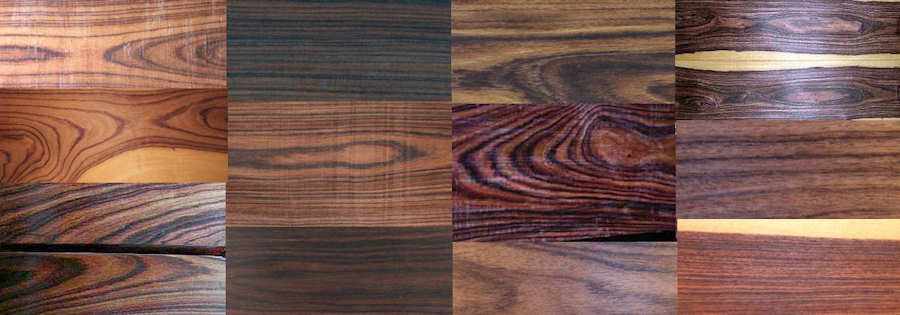
TULIPWOOD (Dalbergia decipularis / Dalbergia frutescens; see my fact sheet for a discussion of the species names) This is the lightest of the rosewoods in color and generally is a beautiful salmon red with lighter stripes. Although somewhat more bland in grain variability than many of the rosewood, this is a strikingly beautiful wood. Even more than most rosewoods, tulipwood suffers from the fact that the trees are small and typically misshapen, thus making the wood available only in small to modest sizes. A 10" wide plank of tulipwood is a real treasure; 3" wide planks are more the norm. Like some of the other rosewoods, it sometimes develops incredibly thin cracks that often can't even be seen until the wood is worked and a finishing agent is applied. Density is in the 65 lbs/cuft range. Cost ranges from $50/BF to $80/BF based on quality (watch out for cracks) and availability is very low.
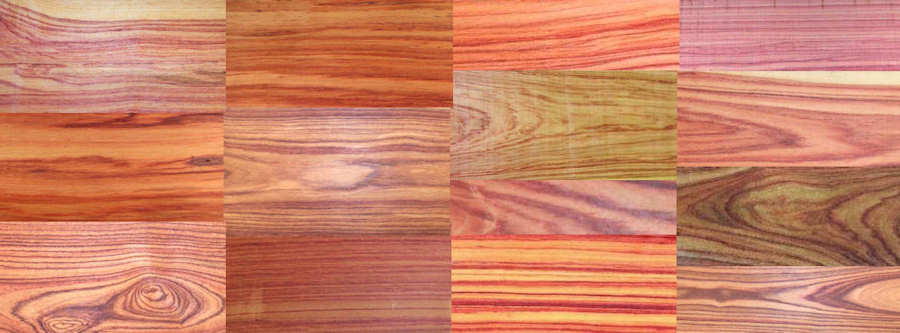
COMMON SUBSTITUTES FOR GENUINE ROSEWOOD
The woods presented here are commonly used when beauty is desired, but on a budget, and the descriptions here are primarily about APPEARANCE. See my web site for more details on working characteristics. Also, where more than one species uses a name, I only present here the generic form genus spp. and more details are available on my web site.
BOCOTE (Cordia spp.) Although not a true rosewood, bocote, is still to my mind more attractive and more interesting than some of the true rosewoods. The heartwood is a golden yellow/green/tan with a background of very dark veining all in a sometimes really wild figure pattern that is absolutely striking. It's only available in small sizes. Like cocobolo, it is very oily/waxy and particularly resistant to oil-based finishes. One severe problem with bocote is that it darkens very considerably with age ... I have seen it turn basically black over a long period of time and even with multiple layers of UV-blocking polyurethane finish, it still darkens quite a lot. It is quite dense, generally weighing from 60 to 70 lbs/cuft when kiln dried. Cost is in the $20/BF range.
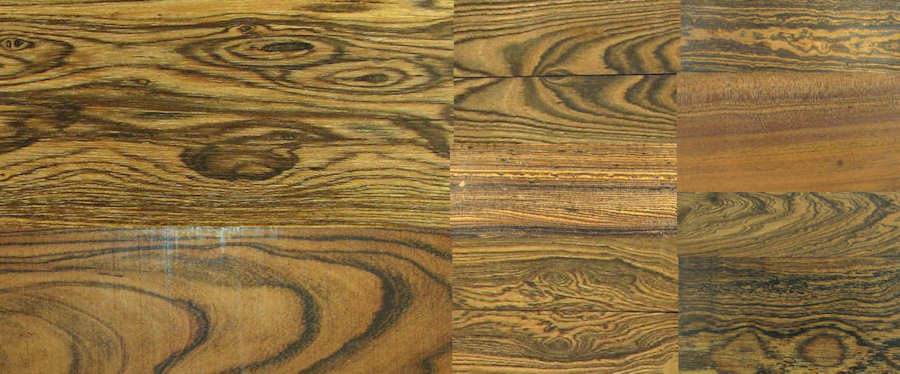
BOLIVIAN ROSEWOOD (Machaerium spp. also commonly sold in the USA as morado) The heartwood ranges from brown to purple/brown, sometimes with red or yellow tinges, and a dark veining, which while quite attractive does not approach the rosewoods in variablity or beauty. Generally cheaper than the rosewoods, it is in the $20/BF range. It is fairly fine-textured and very pleasant to work and does not have the oiliness of the rosewoods. Density is in the 50 lb/cuft range making it a little lighter than most rosewoods.

BUBINGA (Guibourtia spp.), also called "African Rosewood", bubinga is a very attractive purple/red with dark veining and comes in a variety of figures, some of which are just jaw-dropping. Sometimes strikingly similar to Honduras rosewood, this is a very dense and medium-fine-textured wood, available in very large sizes (the trees can be huge) and sometimes subject to drying difficulties. Because the trees are so large, veneer of this wood is common. Rotary cut veneer, which has a marvelously swirly figure, is called kevazinga (in the composite pic below, the second pic from the left in the bottom row is kevazinga; the piece directly above that is flat cut). Bubinga is very inexpensive (in the $10/BF range for normal wood, specialty figures can get VERY expensive) for one of the more attractive exotics, but is generally much less variegated in pattern than the rosewoods and aside from the specialty figures it is not, to my mind, much of a substitute for the rosewoods. Even the specialty figures are not actually substitutes for the rosewoods, but they are often astoundingly beautiful in their own right. Generally 50 to 60 lbs/cuft. In the composite pic below, I show only SOME of the fancy figures that are available in bubinga. The shiny surface on a the pics in the upper right and middle left is NOT natural and is the result of image manipulation by a particular vendor.
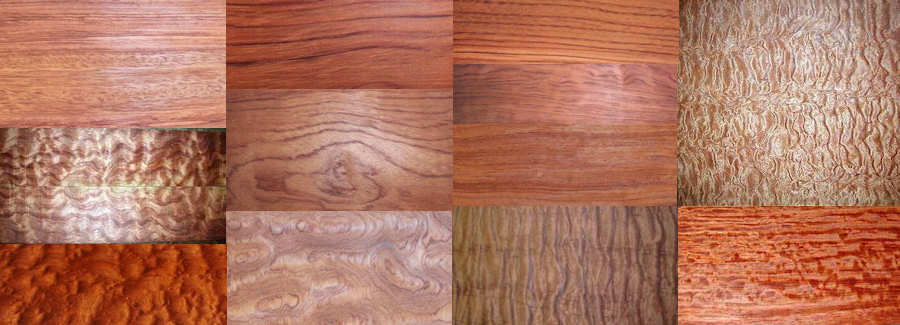
PLANTATION GROWTH
Embargoes help sustainability but as natural growth of the rosewoods continues to decrease due to overcutting, as it almost certainly will, plantation growth offers some hope of continued sustainability, albeit of a somewhat lesser breed of wood.
In Indonesia, for example, East Indian rosewood (Dalbergia latifolia) is widely grown on plantations, and in South America some of the other rosewoods are similarly grown, although not yet to the same extent [as I write this in 2011]. Plantation trees are planted in regular rows and do not have the undergrowth of natural forests, nor do they have competition for light from other surrounding species that may be taller. Also, the soil in the area of growth tends to have much more regularity than that in areas of natural growth. Thus plantation grown trees tend to be more bland than "wild" growth trees, with more regularly spaced (and wider) growth rings and a less diverse color variation both within one tree and from tree to tree due to the regularity of the soil and the overall regularity of all of the growth conditions. BUT ... plantation grown trees are sustainable and can be economically and readily harvested.
TOXICITY
I've always thought that the commonly used term "toxicity" as regards woods is an overstatement (since it means, literally, poisonous and possibly fatal), although not in every case. There ARE woods that actually produce deadly poisons, but not very many and the rosewoods are not among them.
Some of the rosewoods ARE, however, what are more accurately categorized as "irritants" and some are even "sensitizers". The irritation can be from the oil in the wood or from the dust when the wood is worked and may take the form of lung-, skin-, or eye-irritants. Also skin irritants, especially, are sometimes "sensitizers" which means that the reaction is cumulative --- after a bad first reaction to the dust on your skin, the next time you get the dust on your skin the reaction is worse, and it continues to get worse and worse upon subsequent exposures.
Tree leaves and fruit and bark can also be sources of such irritants.
In most cases, rosewoods cause no adverse reaction and even those that do cause problems don't do it with every person. There are numerous tables of wood toxicity on the internet (there is one on my site and links to others).
I personally have had all three irritant reactions with cocobolo and none with any other rosewood. With cocobolo, I once had a skin reaction, but it was not a sensitizer for me and I regularly get cocobolo dust on my arms now with no effect at all. You may not be so lucky. I had to go to the emergency room once because of an extreme irritation to my eyes from cocobolo dust, but have never had another reaction with my eyes. Similarly, I once (very early in my woodworking days) had to go to the emergency room due (unknown to me at the time) to breathing cocobolo dust. I subsequently started wearing a dust mask (ALWAYS) and have had no further problem.
I HIGHLY advise you to wear a dust mask when sanding ANY wood, but especially the rosewoods, and if you notice any irritation on your skin from the dust, wear long sleeves (preferably on a hooded sweatshirt) thereafter, and possibly gloves if you continue to work with the suspect wood.
CONCLUSIONS
Despite concerns about incorrectly or falsely indentified woods, sustainability, toxicity, expense, and other issues, rosewoods are among the most pleasant woods to work with, especially because they can produce stunningly attractive results in created objects. Some care and special considerations are sometimes required, as noted in this article, but they are well worth the trouble and I highly recommend the rosewoods as well worth the expense and effort.










